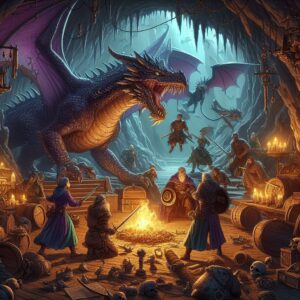Dungeons & Dragons is a tabletop role-playing game (RPG) that has been captivating imaginations since the 1970s. It’s a game where creativity, strategy, and storytelling merge, with players assuming the roles of characters adventuring through fantasy worlds crafted by the Dungeon Master (DM).
Boss Monster first hit the scene in 2013. It’s a card game that flips the usual script by having players take on the role of the villain, building a dungeon to lure in and defeat heroes. It’s an inventive take on dungeon design, packaged in a rapid and accessible format.
Dungeon Design in D&D
Crafting a narrative requires a DM to weave a captivating tale that can adapt and evolve. Every dungeon, regardless of its size or complexity, tells a story. From ancient ruins shrouded in mystery to a fortress teeming with political intrigue, the narrative sets the stage for the adventures that unfold within its walls.
 When designing a dungeon, a DM considers the backstory: Why was this place created? Who or what inhabits it now? What secrets does it hold? These questions help in forming a compelling narrative that guides the adventurers as they explore the dungeon. This narrative foundation encourages players to engage more deeply with the environment and its inhabitants.
When designing a dungeon, a DM considers the backstory: Why was this place created? Who or what inhabits it now? What secrets does it hold? These questions help in forming a compelling narrative that guides the adventurers as they explore the dungeon. This narrative foundation encourages players to engage more deeply with the environment and its inhabitants.
A significant aspect of narrative crafting in D&D is how well it integrates the backgrounds and motivations of player characters (PCs). A well-designed dungeon provides opportunities for PCs to explore their backstory, face personal challenges, or achieve individual goals. A dungeon could contain artifacts related to a character’s heritage or enemies from a character’s past.
A dynamic dungeon adapts to the choices players make, leading to multiple pathways and outcomes. This level of interactivity ensures that players remain engaged, knowing their actions have tangible effects on the story’s direction and outcome.
Player engagement is further heightened by the challenges and rewards embedded within the dungeon narrative. Puzzles, traps, and enemies serve as obstacles that test the players’ strategy, creativity, and teamwork. Overcoming these challenges progresses the storyline, revealing more about the dungeon’s mysteries.
Rewards, information, or alliances, motivate the adventurers to delve deeper into the dungeon and face greater dangers. Rewards can tie back to the overarching narrative, offering insights into the dungeon’s lore or clues that propel the adventurers toward their next quest.
Dungeon Construction in Boss Monster
At the core of Boss Monster lies the strategy of card placement. Each card represents a room in the dungeon, and each room has its unique ability and hero lure value. The order in which rooms are placed and their strategic positioning plays a vital role in the dungeon’s effectiveness. A well-planned dungeon layout can mean the difference between enticing a hero into a fatal trap and failing to prevent their escape.
The challenge of strategic placement is amplified by the limited space for room cards. With only a few slots available, players must make critical decisions about which rooms to build and where to place them to create a synergistic and lethal path. The spatial aspect of dungeon design in Boss Monster requires players to think meticulously about how each room will function within the sequence to maximize damage and treasure, ultimately leading to the hero’s demise.
The game’s strategic depth is enriched by the way certain room cards can enhance or complement the abilities of others. Some rooms might increase their damage output when followed by certain types of rooms, or others might have abilities that trigger under specific conditions provided by adjoining rooms. This encourages players to consider how those abilities can be amplified through smart placement and combination. Mastering these synergies enables players to craft deadly room sequences that can stop even the most formidable heroes in their tracks.
The goal is to construct a dungeon that is attractive enough to lure heroes in but deadly enough to ensure they do not survive the journey. Players must carefully consider the types of treasure their rooms offer and how those treasures align with the heroes they aim to attract.
As the game progresses and more powerful heroes enter the fray, players must adapt their strategies to ensure their dungeons evolve accordingly. Upgrading rooms and employing advanced traps become important to dealing with the increasing threat level. This dynamic aspect of dungeon construction keeps players engaged and constantly strategizing to maintain the perfect balance between attracting heroes and ensuring their downfall.
Community and Solo Play
Dungeons & Dragons is designed around the concept of collaborative storytelling, where a group of players, led by a Dungeon Master (DM), embark on imaginary adventures in a fantasy world. The communal aspect of D&D is foundational, providing a structured yet flexible framework where players can interact, strategize, and shape the narrative together.
 Players bring their unique characters to life, each contributing to the unfolding story with their skills and decisions. The DM facilitates the game, tailoring challenges and story arcs that incorporate the characters’ backgrounds and motivations. This cooperative storytelling creates a shared experience, bonding players through their triumphs, setbacks, and the collective imagination of their adventure.
Players bring their unique characters to life, each contributing to the unfolding story with their skills and decisions. The DM facilitates the game, tailoring challenges and story arcs that incorporate the characters’ backgrounds and motivations. This cooperative storytelling creates a shared experience, bonding players through their triumphs, setbacks, and the collective imagination of their adventure.
D&D has a vast global community, with players sharing experiences, advice, and custom content online. Conventions, local gaming groups, and online platforms serve as hubs where enthusiasts gather, discuss strategies, and celebrate the culture surrounding the game.
Boss Monster introduces elements conducive to both community and solo play but stands out in its accessibility to solo gamers. This card game challenges players to build dungeons that attract and destroy heroes, with mechanics and objectives that are straightforward yet strategically complex enough to engage players in a solo setting.
Solo play in Boss Monster allows players to enjoy the game at their own pace, focusing on strategy refinement and personal achievement. Playing solo offers a unique opportunity to delve deeply into the game’s mechanics, experiment with different strategies, and understand the nuances of card combinations without the influence of competitive or cooperative play. This mode of engagement is particularly appealing to players looking for a challenging and satisfying experience without the need for a group.
Boss Monster’s solo play does not isolate players from the wider community. The game’s enthusiasts share strategies, solo challenge scenarios, and experiences in online forums and communities. This blend of solo gameplay and community interaction provides a unique gaming experience, allowing players to enjoy the best of both worlds.